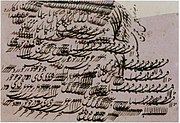Mirza Mohammad Reza Kalhor
Mirza Mohammad Reza Kalhor | |
|---|---|
 | |
| Born | c. 1829 |
| Died | 1892 |
| Resting place | Ḥasanābād cemetery |
| Known for | Calligraphy |
| Style | Nastaʿlīq script technique |
| Children | 9 |
Mirza Reza Kalhor (Persian: محمدرضا کلهر; c. 1829 – 1892) was a 19th-century Iranian calligrapher, known for his mastery of the Nastaʿlīq script technique.[1]
A member of the Kurdish Kalhor tribe of Kermanshah, he initially followed the typical tribal path, learning horsemanship and sharpshooting. He gained an interest in calligraphy as a child, and left the tribe for further training.[1] During his career, he introduced several innovations to Nastaʿlīq calligraphy, changing both the aesthetics and mechanics of the technique.[1]
Kalhor modified and adapted Nastaʿlīq to be easily used with printing machines and newspaper lithography, which in turn helped wide dissemination of his transcripts.[1][2] He also devised methods for teaching Nastaʿlīq and specified clear proportional rules for it, which many could follow.[1]
He died of cholera in Tehran at age 65, having sired nine children and taught many calligraphy students, several of whom went on to become notable in their own right.[1] He was buried in Ḥasanābād cemetery.[1]
- Page of mashq. 'Ali Jamasb Collection, Tehran
- Page of mashq. Private Collection, Tehran
- Page of mashq. Archive of Iran's Association of Calligraphers
References
- ^ a b c d e f g "KALHOR, Mirzā Mohammad-Reżā". Encyclopedia Iranica. Retrieved 1 December 2012.
- ^ Bahman Eslami (25 November 2013). "Harir – Reducing Noise in Arabic Script". Retrieved 25 November 2015.



